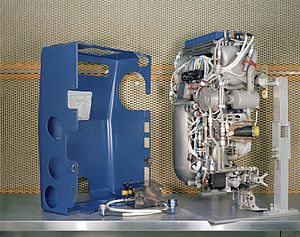
A life-support system is the combination of equipment that allows survival in an environment or situation that would not support that life in its absence. It is generally applied to systems supporting human life in situations where the outside environment is hostile, such as outer space or underwater, or medical situations where the health of the person is compromised to the extent that the risk of death would be high without the function of the equipment.[1]
In human spaceflight, a life-support system is a group of devices that allow a human being to survive in outer space. US government space agency NASA,[2] and private spaceflight companies use the phrase "environmental control and life-support system" or the acronym ECLSS when describing these systems.[3] The life-support system may supply air, water and food. It must also maintain the correct body temperature, an acceptable pressure on the body and deal with the body's waste products. Shielding against harmful external influences such as radiation and micro-meteorites may also be necessary. Components of the life-support system are life-critical, and are designed and constructed using safety engineering techniques.
In underwater diving, the breathing apparatus is considered to be life support equipment, and a saturation diving system is considered a life-support system – the personnel who are responsible for operating it are called life support technicians. The concept can also be extended to submarines, crewed submersibles and atmospheric diving suits, where the breathing gas requires treatment to remain respirable, and the occupants are isolated from the outside ambient pressure and temperature.
Medical life-support systems include heart-lung machines, medical ventilators and dialysis equipment.
- ^ "Definition of LIFE-SUPPORT SYSTEM". www.merriam-webster.com. Retrieved 14 June 2023.
- ^ NASA, 2008
- ^ Barry 2000.